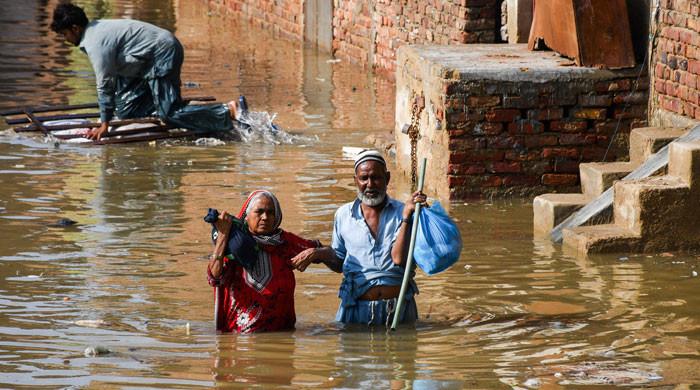Monsoon Rains Claim 802 Lives in Pakistan
The National Disaster Management Authority (NDMA) reported on Tuesday that the death toll from this year’s monsoon rains in Pakistan has reached 802. Additionally, over 1,088 individuals have sustained injuries, and approximately 7,465 residences have suffered damage.
Regional Breakdown of Casualties
- Khyber Pakhtunkhwa (KP) recorded the highest number of deaths at 479.
- Punjab reported 165 fatalities.
- Gilgit-Baltistan experienced 45 deaths.
- Sindh reported 57 deaths.
- Balochistan and Azad Jammu and Kashmir (AJK) both recorded 24 deaths.
- Islamabad reported eight fatalities.
Of the deceased, 480 were men, 119 were women, and 203 were children.
Injuries and Property Damage
Punjab reported 584 injuries, KP 347, Sindh 75, GB 45, AJK 29, Balochistan five, and Islamabad three. Significant property damage occurred, with 4,243 houses damaged in KP, 1,642 in AJK, 1,029 in GB, 220 in Punjab, 175 in Balochistan, 91 in Sindh, and 65 in Islamabad.
Government Response and Evacuation Efforts
Prime Minister Shehbaz Sharif convened a high-level meeting regarding the flood situation. He was informed that over 174,000 individuals had been evacuated from flooded districts in Punjab due to the overflowing River Sutlej.
The Prime Minister instructed officials to expedite rescue efforts, especially in the areas most affected along the river, and to ensure the prompt delivery of essential supplies like food, medical provisions, and temporary shelters.
The NDMA chairman was tasked with maintaining close communication with the Punjab Provincial Disaster Management Authority (PDMA).
Warnings and River Conditions
Authorities indicated that early warnings facilitated evacuations, mitigating casualties in certain regions despite severe flooding in River Sutlej at Ganda Singh Wala and Sulemanki, River Ravi at Jassar, and River Chenab at Marala. Significant flooding was also reported in Nullah Dek.
In Narowal, evacuations were underway in the Lehri Bund area, while efforts to restore power were in progress in parts of KP.
In Gilgit-Baltistan, repair work was ongoing on a two-kilometer segment of the submerged National Highway. Forecasts indicated heavy rainfall in Lahore, Gujranwala, Gujrat, Rawalpindi, AJK, and several Gilgit-Baltistan districts over the next 12 to 24 hours.
Impact of Water Release from India
The flood situation worsened after India released additional water into Pakistan’s rivers. Consequently, the Ravi, Chenab, and Sutlej rivers experienced surges, leading to breaches in Narowal, Sialkot, and Shakargarh.
In Zafarwal, a segment of Hanjli Bridge collapsed due to the pressure from Nullah Dek, disconnecting road access to numerous villages.
At Head Marala on the Chenab, water inflow increased to 350,000 cusecs, while the Sutlej’s flow at Ganda Singh Wala rose to 188,000 cusecs, reaching extremely high flood levels.
In Khairpur Tamewali, Bahawalpur, and adjacent river belt areas, floodwaters rapidly spread, causing damage to crops across thousands of acres, as well as houses and government schools.
Sialkot recorded 335 millimetres of rainfall within 24 hours, resulting in widespread inundation and disruption, breaking an 11-year-old record.
India’s release of an additional 200,000 cusecs into the Ravi and the anticipated 100,000 cusecs into the Chenab has heightened concerns of very high flooding in the next 48 hours.
Ongoing Rescue Efforts and Casualties
Rescue teams continued to evacuate stranded residents from river-adjacent areas via boats. Nullah Bainsi and Nullah Basantar in Shakargarh overflowed, submerging connecting roads and various villages.
In Shakargarh, a roof collapse resulted in the death of one woman and injuries to two children.
In the Buner district, the Sikh community’s only cremation ground was washed away, along with businesses and shops, prompting calls for governmental assistance.
In Chagharzai tehsil, 18 members of a single family were collectively mourned after being swept away by floodwaters. The body of one child remained missing, creating a somber atmosphere.
In Shangla’s Khwar Banda area, nine members of another family perished in the floods. A man named Rafiullah lost two sons and a daughter in the disaster, and his wife is reportedly experiencing severe emotional distress.
PM’s Address on Climate Change
Prime Minister Shehbaz Sharif reiterated that Pakistan is among the nations most vulnerable to climate change. He recalled that the floods of 2022 caused losses amounting to $30 billion, displacing millions and devastating entire villages.
Call for Global Action
“We cannot confront this challenge alone,” he stated during an event, advocating for coordinated international cooperation.
NDMA Briefing and Concerns
The NDMA chairman informed the Public Accounts Committee that Pakistan is home to approximately 7,500 glaciers, cautioning that a two-degree temperature increase could lead to the melting of 65 percent of them within the next five decades.
Legislators criticized the NDMA’s perceived lack of preparedness. Committee member Junaid Akbar commented that the authority seemed primarily equipped for tasks like recovering bodies and repairing roadways.
Another member, Sanaullah Masti Khel, alleged that funds allocated for early warning systems were redirected to the Benazir Income Support Programme, and he expressed intentions to file a First Information Report (FIR) if authorized.
The NDMA chief also warned that the eighth spell of monsoon rains is anticipated to commence tomorrow.



Comments (0)
No comments yet. Be the first to comment!
Leave a Comment